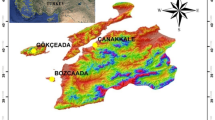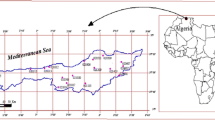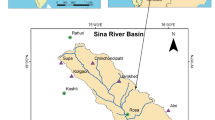Abstract
Drought is accounted as one of the most natural hazards. Studying on drought is important for designing and managing of water resources systems. This research is carried out to evaluate the ability of Wavelet-ANN and adaptive neuro-fuzzy inference system (ANFIS) techniques for meteorological drought forecasting in southeastern part of East Azerbaijan province, Iran. The Wavelet-ANN and ANFIS models were first trained using the observed data recorded from 1952 to 1992 and then used to predict meteorological drought over the test period extending from 1992 to 2011. The performances of the different models were evaluated by comparing the corresponding values of root mean squared error coefficient of determination (R 2) and Nash–Sutcliffe model efficiency coefficient. In this study, more than 1,000 model structures including artificial neural network (ANN), adaptive neural-fuzzy inference system (ANFIS) and Wavelet-ANN models were tested in order to assess their ability to forecast the meteorological drought for one, two, and three time steps (6 months) ahead. It was demonstrated that wavelet transform can improve meteorological drought modeling. It was also shown that ANFIS models provided more accurate predictions than ANN models. This study confirmed that the optimum number of neurons in the hidden layer could not be always determined using specific formulas; hence, it should be determined using a trial-and-error method. Also, decomposition level in wavelet transform should be delineated according to the periodicity and seasonality of data series. The order of models with regard to their accuracy is as following: Wavelet-ANFIS, Wavelet-ANN, ANFIS, and ANN, respectively. To the best of our knowledge, no research has been published that explores coupling wavelet analysis with ANFIS for meteorological drought and no research has tested the efficiency of these models to forecast the meteorological drought in different time scales as of yet.



Similar content being viewed by others
References
Abramowitz M, Stegun A (1965) Handbook of mathematical formulas, graphs, and mathematical tables. Dover Publications, Inc, New York
Adamowski J (2007) Development of a short-term river flood forecasting method based on wavelet analysis. Polish Academy of Sciences Publication, Warsaw, p 172
Adamowski J, Fung Chan H (2011) A wavelet neural network conjunction model for SPI index forecasting. J Hydrol 407:28–40
Agarwal A, Mishra SK, Ram S, Singh JK (2006) Simulation of runoff And sediment yield using artificial neural networks. Biosyst Eng 94(4):597–613
Altunkaynak A, Ozger M, Cakmakcı M (2005) Water consumption prediction of Istanbul City by using fuzzy logic approach. Water Resour Manag 19:641–654
Canon J, Gonzalez J, Valdes J (2007) Precipitation in the Colorado River Basin and its low frequency associations with PDO and ENSO signals. J Hydrol 333:252–264
Chou FNF, Chen BPT (2007) Development of drought early warning-index: using neuro-fuzzy computing technique. In: 8th international symposium on advanced intelligence systems 2007 Korea. Paper No: A 1469
Christopoulou EB, Skodras AN, Georgakilas AA (2002) The ‘‘Trous’’ wavelet transform versus classical methods for the improvement of solar images. In: Proceedings of 14th international conference on digital signal processing 2:885–888
Cohen A, Kovacevic J (1996) Wavelets: the mathematical background. Proc IEEE 84:514–522
Daubechies I (1990) The wavelet transform, time-frequency localization and signal analysis. IEEE Trans Inf Theory 36:961–1005
Duggins J, Williams M, Kim DY, Smith E (2010) Changepoint detection in SPI transition probabilities. J Hydrol 388:456–463
Dupuis D (2010) Statistical modeling of the monthly palmer drought severity index. J Hydrol Eng 15(10):796–807
Edwards DC, McKee TB (1997) Characteristic of 20th century drought in the United States at multiple timescales. Colorado State University: Fort Collins, Climatology Report
Elman JL (1988) Finding structure in time. CRL Technical Report 8801. Centre for Research in Language, University of California at San Diego
Firat M, Gungor M (2007) River flow estimation using adaptive neuro-fuzzy inference system. Math Comput Simul 75(3–4):87–96
Firat M, Gungor M (2008) Hydrological time-series modeling using adaptive neuro-fuzzy inference system. Hydrol Process 22(13):2122–2132
Grossman A, Morlet J (1984) Decompositions of hardy functions into square integrable wavelets of constant shape. SIAM J Math Anal 15:723–736
Hana P, Wang PX, Zhang ShY, Zhu DH (2010) Drought forecasting based on the remote sensing data using ARIMA models. Math Comput Model 51:1398–1403
Haykin S (1999) Neural networks, a comprehensive foundation, 2nd edn. Prentice-Hall, Englewood Cliffs, NJ, pp 135–155
Jain A, Kumar AM (2007) Hybrid neural network models for hydrologic time series forecasting. Appl Soft Comput 7:585–592
Jang JSR (1993) ANFIS: adaptive network based fuzzy interface system. Proc IEEE Trans Syst Man Cybern 23:665–685
Jang JSR, Sun CT (1995) Neuro-fuzzy modeling and control. Proc IEEE 83:378–406
Jang JSR, Sun CT, Mizutani E (1997) Neuro-fuzzy and soft computing: a computational approach to learning and machine intelligence. Prentice-Hall, Eaglewood cliffs, NJ, pp 665–685
Jeong D, Kim YO (2005) Rainfall-run off models using artificial neural networks for ensemble stream flow prediction. Hydrol Process 19:3819–3835
Kao SC, Govindaraju RS (2010) A copula-based joint deficit index for droughts. J Hydrol 380:121–134
Kavzoglu T, Mather PM (2003) The use of back-propagating artificial neural networks in land cover classification. Int J Remote Sens 24:4907–4938
Keskin ME, Terzi O, Taylan D (2004) Fuzzy logic model approaches to daily pan evaporation estimation: in western Turkey. Hydrol Sci 49:1001–1010
Kumar ARS, Sudheer KP, Jain SK, Agarwal PK (2005) Rainfall-runoff modeling using artificial neural networks: comparison of network types. Hydrol Process 19:1277–1291
Lloyd-Hughes B, Saunders MA (2002) A drought climatology for Europe. Int J Clim 22:1571–1592
Maier HR, Dandy GC (1998) The effect of internal parameters and geometry on the performance of back-propagation neural networks: an empirical study. Environ Model Softw 13:193–209
Mantoglou A (2003) Estimation of heterogeneous aquifer parameters from piezometric data using ridge functions and neural networks. Stoch Environ Res Risk Assess 17:339–352
McKee TB, Doesken NJ, Kleist J (1993) The relationship of drought frequency and duration to time scales. In: Preprints, 8th conference on applied climatology. 17–22 Jan, Anaheim, California, pp 179–184
Mishra AK, Desai VR (2006) Drought forecasting using feed-forward recursive neural network. Ecol Model 198:127–138
Mishra AK, Singh VP (2010) A review of drought concepts. J Hydrol 391:202–216
Mishra A, Desai V, Singh V (2007) Drought forecasting using a hybrid stochastic and neural network model. J Hydrol Eng 12(6):626–638
Moreira EE, Paulo AA, Pereira LS, Mexia JT (2006) Analysis of SPI drought class transitions using loglinear models. J Hydrol 331:349–359
Moreira EE, Coelho CA, Paulo AA, Pereira LS, Mexia JT (2008) SPI-based drought category prediction using loglinear models. J Hydrol 354:116–130
Morid S, Smakhtin V, Bagherzadeh K (2007) Drought forecasting using artificial neural networks and time series of drought indices. Int J Climatol 27:2103–2111
Nagy HM, Watanabe K, Hirano M (2002) Prediction of sediment load Concentration in rivers using artificial neural network model. J Hydraul Eng 128:588–595
Nayak PC, Sudheer KP, Ramasastri KS (2005) Fuzzy computing Based rainfall-runoff model for real time flood forecasting. Hydrol Process 19:955–968
Nourani V, Kisi Z, Mehdi K (2011) Two hybrid artificial intelligence approaches for modeling rainfall-runoff process. J Hydrol 402:41–59
Partal T (2009) River flow forecasting using different artificial neural network algorithms and wavelet transform. Can J Civil Eng 36:26–38
Pulido-Calvo I, Gutierrez-Estrada JC (2009) Improved irrigation water demand forecasting using a soft-computing hybrid model. Biosyst Eng 102(2):202–218
Rajaee T (2011) Wavelet and ANN combination model for prediction of daily suspended sediment load in rivers. Sci Total Environ 409:2917–2928
See L, Openshaw S (1999) Applying soft computing approaches to river level forecasting. Hydrol Sci J des Sci Hydrol 44:763–777
Sen Z, Altunkaynak A (2006) Prediction of Istanbul City by using fuzzy logic approach. Water Runoff coefficient and runoff estimation. Hydrol Process 20:1993–2009
The White House (2006) The federal response to Hurricane Katrina: lessons learned. http://www.whitehouse.gov/reports/katrina-lessons-learned/
Thom HCS (1958) A note on the gamma distribution. Month Wat Rev 86(4):117–122
UNDP (2005) Reducing risks from tsunamis: disaster and development, bureau for crisis prevention and recovery, United Nations Development Programme. http://www.undp.org/cpr/disred/documents/tsunami/undp/rdrtsunamis.pdf
Wilks DS (1995) Statistical methods in the atmospheric sciences. An introduction. Academic Press, London
World Bank Independent Evaluation Group (2006) Hazards of nature, risks to development. World Bank Publications, Washington, DC
Wu JD, Li N, Yang HJ, Li CH (2008) Risk evaluation of heavy snow disasters using BP artificial neural network: the case of Xilingol in Inner Mongolia. Stoch Environ Res Risk Assess 22:719–725. doi:10.1007/s00477-007-0181-7
Yahiaoui A, Touaïbia B, Bouvier C (2009) Frequency analysis of the hydrological drought regime. Case of oued Mina catchment in western of Algeria, Revue Nature et Technologie, pp 3–15
Acknowledgments
The authors are grateful to the East Azerbaijan regional water authority for their constructive suggestions and data that have improved the scientific quality of this paper.
Author information
Authors and Affiliations
Corresponding author
Rights and permissions
About this article
Cite this article
Shirmohammadi, B., Moradi, H., Moosavi, V. et al. Forecasting of meteorological drought using Wavelet-ANFIS hybrid model for different time steps (case study: southeastern part of east Azerbaijan province, Iran). Nat Hazards 69, 389–402 (2013). https://doi.org/10.1007/s11069-013-0716-9
Received:
Accepted:
Published:
Issue Date:
DOI: https://doi.org/10.1007/s11069-013-0716-9




